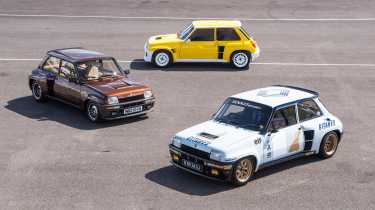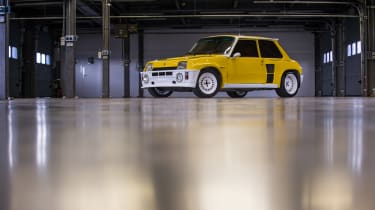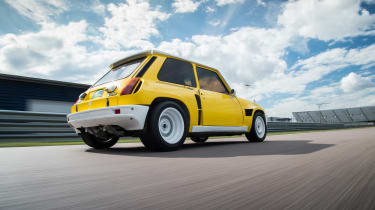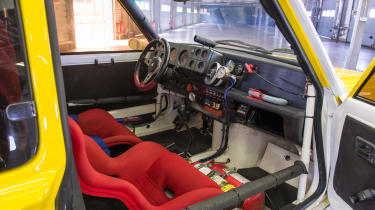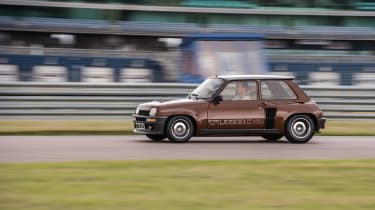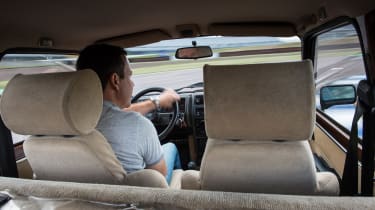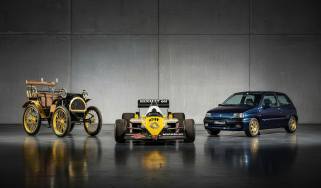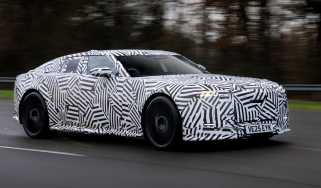Renault 5 Turbo group test – hot hatch icons go head-to-head
42 years after its unveiling, we've gathered together 3 Renault 5 Turbos to see how the legend is faring
When I was an impressionable youth back in the last quarter of the 20th century, the word ‘turbo’ really meant something. Throttle response you could measure with an egg timer, certainly, but it also possessed a blend of menace and madness born of rallying and grenade-spec F1 Grand Prix cars.
Of all the cars to come from that hedonistic high-boost era, the Renault 5 Turbo is one of the few to still hold us in its thrall. The lunacy of the mid-engined, wide-body concept surely sees to that, but reputation, rarity and rally pedigree are the magical fairy dust that ensures it retains a mystique and potency matched by few forced-induction cars before or since.
> New Renault 5 unveiled – meet the basis for Alpine’s electric hot hatch
To see a solitary Turbo is special. To see a brace is exceptional. To see three, in distinct states of tune, from factory-standard perfection to full factory Group B rally specification, is an amazing day indeed. It’s all come about thanks to Renault 5 Turbo specialist Olly Melliard, who correctly deduced that if he could assemble the right cars, evo would snatch his arm off to drive them. That one has been trailered all the way from Greece for the test only makes the gathering more remarkable.
And so to Rockingham Motor Speedway. Not, it has to be said, the first place you’d imagine finding a trio of Renault’s iconic Supercinq, but as good a place as any to get a taste of what they have to offer, and a safe environment in which to at least attempt to explore the notoriously tricky limits of this no-prisoners hatchback.
It makes sense to work my way up to the full-on rally car, which is fine by me as it means my first port of call is Darren Monk’s magnificent late-model Turbo 2. As its name suggests, the Turbo 2 was the second iteration of the mid-engined Renault 5. The original Turbo, built from 1980 to 1983, had its doors, tailgate and roof made from aluminium for homologation purposes. The Turbo 2, produced from 1983 to 1986, had these panels in steel to help keep costs down, but is no less fearsome for it.
Monk’s car is acknowledged as the finest standard T2 in the UK, and one of the best in the world. The condition and colour – listed as a ‘Brun 769’, in case you were wondering – are absolutely perfect. Walking up to the driver’s door and sliding behind the wheel, I reckon I know just how the original owner felt when the car was delivered to Ringles Garage in Sussex. After a short while and minimal miles, the car was sold to a buyer in Northern Ireland who used it until 1994, at which point it was put in storage. It emerged 14 years later, only to be sold back to Britain and spend a further seven years in storage before Darren rescued it and recommissioned it. Refreshed, but absolutely not restored, its originality (even down to the fitment of fresh OE Michelin TRX tyres) is mind-blowing.
> Renault 5 Turbo: review, history and specs of an icon
Ignore the wide arches. When you sit in a T2 you’re effectively sat in a regular R5. That means a small and narrow cabin with the upright windscreen sat on the end of your nose. The gearlever is long, the driving position and pedals are offset, and the steering wheel is canted so your left arm feels more outstretched than your right. The plush seats so typical of Renaults of this era, but not of Renault 5s or indeed rally specials, are comfortable and supportive, while a sweet array of Jaeger dials with orange graphics completes the period ’80s look.
There’s decent weight to the controls and the throttle pedal has a long travel. The gearshift is light, precise and has a shorter throw than the length of the lever leads you to expect. Look ahead and you can kid yourself you’re in a mildly sporty R5, but look behind you and you’re left in no doubt you’re in something altogether more extreme.
The engine sounds bigger and ballsier than its capacity suggests, with an endearing off-beat burble and gruff, throaty note when working hard. The boost gauge begins to twitch at around 3000rpm and whips round beyond 4000rpm, but you need full throttle to wake the little 1.4-litre pushrod motor. By modern standards the power and torque figures are rather feeble, the Turbo’s reputation setting an expectation that 160bhp can’t really hope to meet, yet once boosting it feels undeniably strong.
During the getting-to-know-you phase, the chassis has a nice, neutral balance. The unassisted steering’s not too fast, but not too slow, either. The front end has decent bite and there’s roll and compliance in the suspension, so you feel it soak up the lateral load. You can kid yourself there’s little more to learn, until you decide to provoke it, at which point you discover there’s another side to the Turbo. One in which the tail is happy to take to control.
You know you’re in a hatchback, and an old hatchback at that, but there are hints of 911 about it – an uncorrupted feel to the steering and a slightly pendulous response from the tail that you have to respect but can use to your advantage – that set it apart as something special and a car that takes some learning. It must have felt pretty darned quick in its day, not to mention a challenge to people’s perception of what Renault was about and a real threat to the established performance benchmarks of the day.
If Monk’s T2 is a snapshot of all-original perfection, Tony Campbell’s extensively modified example is a lesson in detail, quality and authentic period upgrades. Like Monk’s car, B803 AGJ was originally supplied to the UK, and as was typical at the time, it was converted to right-hand drive by the first owner. Campbell acquired the car in 2012 and embarked upon a full nut-and-bolt restoration with a view to meeting Group 3 and 4 homologation regulations, so the car could be eligible for historic rallying.
Using a bodyshell with Group 4-spec structural reinforcement and coilover suspension and a Group 3 engine with a ‘Cévennes’ exhaust manifold and intercooler, a modified Garrett T3 turbo and Bosch K-Jetronic fuel injection, it was built and developed by acknowledged classic Renault restorer JL Engineering. It bristles with energy and attitude, and Campbell’s take on the period ‘Gitanes Blondes’ livery is the icing on the cake.
Stripped of most creature comforts but still a useable road car, it’s an altogether angrier proposition. All the inherent qualities and characteristics of Monk’s car remain, but the power delivery (220bhp @ 6900rpm) and handling balance are compressed into a tighter, more intense zone of performance. Harder to tap but a bigger thrill to experience, it’s much closer to the headbanger that legend would have you expect.
The gearshift is sharper thanks to an AP carbon-ceramic paddle clutch. There’s also strong grip and traction and greater bite from the more abrasive brake pads, so you feel more inclined to drive with genuine aggression. You get the same messages, but they come at you faster and you have to act on them more immediately and emphatically if you’re to stay on top of things. If you provoke this car you have to mean it, and be ready to deal with the consequences. It requires quick, confident hands and feet to catch, balance and see a slide through to a smooth conclusion. Lose confidence and things will only get worse. Waspish, rapid, sharp and vocal, this car is an absolute firecracker, even though it’s still some way short of Campbell’s intended ultimate specification.
For that you need look no further than the white and yellow first-gen Turbo of Dimitris ‘Taki’ Manolopoulos. Originally built by the factory and campaigned as a works car in the World Rally Championship, this fabulous old warhorse made its competition debut and sole works outing at the 1981 Monte Carlo Rally, sporting the famous red and orange Calberson livery and with Bruno Saby at the wheel. Retiring from the event midway through, after an accident, the car was taken back to Renault Sport headquarters in Dieppe, where it was repaired and rebuilt to the same to Group 4 spec. Renault then honoured a sale agreement to Greek rally driver and renowned buyer of works Renault competition cars Alexandros ‘Leonidas’ Maniatopoulos, who privately entered the 1982 Acropolis Rally and scored an impressive eighth-place finish.
With the imminent transition from Group 4 to Group B, Leonidas sent the car back again to Dieppe to be updated, whereupon it was placed on the production line of the 20 ‘evolution’ cars required to comply with regulations. The car assumed its new factory Group B identity as ‘Tour de Corse Evolution’ before being delivered back to Greece in the factory yellow and white colours for the 1983 season. Taki then acquired the car in 1984 and has campaigned it with his son, Thomas, in the Greek Hill Climb and Greek National Rally Championships for the last three decades. Scoring some 200 wins, the pair – and car – have achieved cult status amongst Greek fans.
Taki has never let anyone but Thomas drive the car, so you can imagine my apprehension as he straps me in, instructs Thomas to give me a pre-flight briefing, then steps back to let me head out onto the track. This is the real deal. It smells of sweat and speed, of tortured soft-compound rubber and high-octane fuel. Original spare parts are rarer than dodo doo-doo, and such is the state of tune that once its warm you have to keep the engine working hard to avoid fouling the plugs. It’s a no-nonsense, no-prisoners nutter of a thing, and I love it already.
It’s so much more extreme to drive than the others. The noise, the explosive power delivery, the ultra-tight gear ratios and the sharper, grippier chassis making even Campbell’s car feel as mild as a cup of camomile tea. Such is the grip, there’s little sense of the rearward weight bias, even though there’s a far keener rate of turn-in response. On the tight twists and turns of a mountainous tarmac rally stage, I’m sure the added agility and power (around 300bhp, according to Taki) must be an explosive combination, albeit one that takes immense concentration and physical effort to stay on top of. Even with all this grip, in the heat and dust of a flat-out rally stage I’m equally sure it would bite if you misjudged a tightening corner or caught a patch of unseen gravel. The sting in the tail.
The noise is mighty – that characteristic hollow-sounding Group B blare that hardens as the boost builds, then pops and bangs with a fusillade of gunshots as the throttle is snapped shut. It’s almost impossible to believe that this small-capacity four-cylinder engine – just 1397cc – can generate so much sound and fury, but then you recall that when this car was at the cutting edge, this is what turbocharging was all about: fire and brimstone, not flat, featureless plateaus of torque and micromanaged boost pressure.
Taki speaks about as much English as I do Greek, but as I switch off the engine and climb out of the car, my face glistening with sweat and my hands quivering mildly with the adrenalin rush, we exchange a smile that speaks volumes. Were we able to discuss the experience of driving his car in a common tongue, I suspect it would be mostly in words comprised of four letters and unsuited to the pages of evo. Yet despite all this, when it comes to Renault’s most compelling road car, I’m pleased to confirm it’s that magical five-letter word that still packs the biggest punch: Turbo.
Huge thanks to Olly Melliard, Darren Monk, Tony Campbell and Dimitris and Thomas Manolopoulos.
